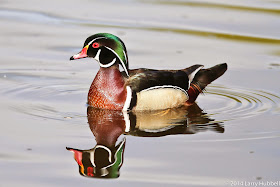A few minutes earlier the female downy woodpecker could be seen looking out from the nesting hole provided by her mate.
She looked first to the left and then to the right…
…before pushing her way out of the nest. It appears the tight fit of the entry hole is designed to minimize the size of possible intruders.
She landed on a nearby branch from which she could watch her mate. The Downy Woodpeckers are very fun to watch due in part to their superior coordination. The female was seen at one point hopping backwards along the top of a branch and the male was seen throwing himself off a branch and falling about three feet before spreading his wings to fly.
Even though the female seems satisfied with the nest, the male is still working away on a second hole about three or four feet below the completed nest. (You can tell how tight the entry is by looking at the ruffled feathers on the back of the male bird.) The purpose of this second hole is a bit of a mystery. Will it still be an alternate nesting site? Will the female move to the new hole when it is complete? Has she laid eggs in the upper hole already?
In any case the male's motivation for this labor of love is quite clear.
On Monday the pair was seen mating on a branch of the nesting tree.
Six minutes later…
…they repeated the process on the other side of the tree. Cornell says the incubation period is about 12 days, but the unknown in the process is when the eggs will be laid.
Also on Monday, the male Pileated Woodpecker, most likely Elvis, was seen feeding nearby.
No crevice is safe from his explorations. The Pileated Woodpeckers are said to trade off on the nesting duties but curiously only the male has been seen for the last month or so. Maybe he has the night shift at the nest?
Another first was seeing Elvis drink from Duck Bay.
He then spent a half hour excavating food from the same log, and in the process this small white bug was photographed in a very dangerous position.
Nearby male Wood Ducks suddenly seem to outnumber the females four to one, which may indicate that some of the females are out of sight while sitting on eggs or tending to young ducklings. Labors of love do seem to fall disproportionately upon the mothers.
Have a great day of Union Bay…where nature lives in the city!
Larry
















Larry, you are a relentless observer. I am in awe of that image of the Pileated Woodpecker with the grub (?) in its open bill. Getting good images of "birds" is one thing, but documenting their behaviors is entirely more challenging. I love the series of the Downys, the one woodpecker species that is rare in our conifer setting on Whidbey. I have some appreciation of how much work and luck (as a direct result of work) it takes to get images like these. Well done, and thank you for sharing them.
ReplyDeleteDan, Thank you for your thoughtful and kind words! The Pileated Woodpeckers are truly amazing to watch. I am sure you have seen it on Whidbey Island, but at the sound of PWs drumming and excavating other birds, like Flickers, will even come and watch. I assume they are hoping for easy food after the Pileated moves on.
DeleteAmazing, as usual!
ReplyDeleteThank you!
DeleteThis is an especially amazing series of photos, Larry. I too spend many hours watching and photographing bird behavior and am blown away by what you were able to capture in these photos. Artistic and beautiful as always, and wonderfully intimate. Thanks for sharing!!
ReplyDeleteThank you! I appreciate your kind comments. Yesterday afternoon, after the rain had started, I walked back over to the Downy nest to see how they were handling the weather. One of them was sitting looking out of the nest, which has the entry situated on the protected "underside" of an almost vertical branch, and watching me carefully. I felt like I could almost see a grin and hear the thoughts, "Hey Silly, What are you doing standing out there in the rain?"
Delete